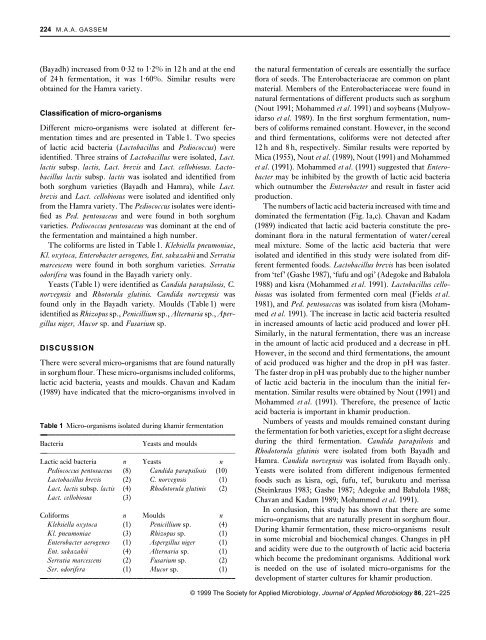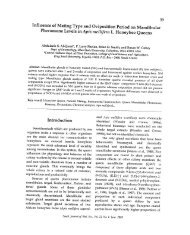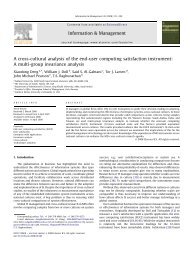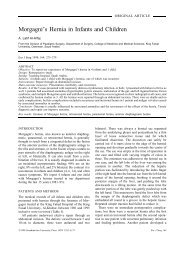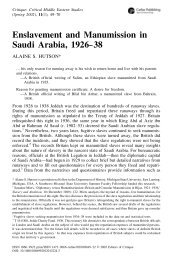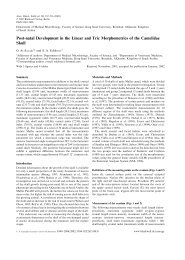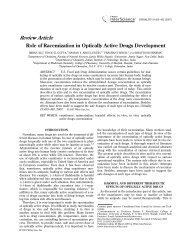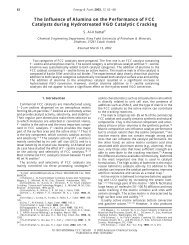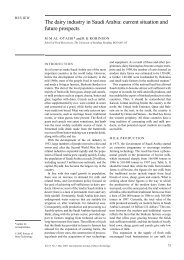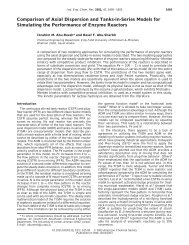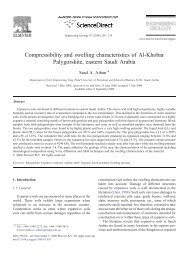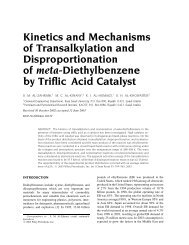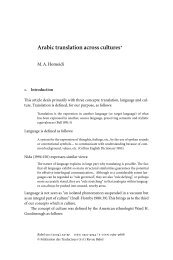(khamir) produced from sorghum in Gizan region, Saudi Arabia
(khamir) produced from sorghum in Gizan region, Saudi Arabia
(khamir) produced from sorghum in Gizan region, Saudi Arabia
Create successful ePaper yourself
Turn your PDF publications into a flip-book with our unique Google optimized e-Paper software.
224 M.A.A. GASSEM<br />
(Bayadh) <strong>in</strong>creased <strong>from</strong> 0·32 to 1·2% <strong>in</strong> 12 h and at the end<br />
of 24 h fermentation, it was 1·60%. Similar results were<br />
obta<strong>in</strong>ed for the Hamra variety.<br />
Classification of micro-organisms<br />
Different micro-organisms were isolated at different fermentation<br />
times and are presented <strong>in</strong> Table 1. Two species<br />
of lactic acid bacteria (Lactobacillus and Pediococcus) were<br />
identified. Three stra<strong>in</strong>s of Lactobacillus were isolated, Lact.<br />
lactis subsp. lactis, Lact. brevis and Lact. cellobiosus. Lactobacillus<br />
lactis subsp. lactis was isolated and identified <strong>from</strong><br />
both <strong>sorghum</strong> varieties (Bayadh and Hamra), while Lact.<br />
brevis and Lact. cellobiosus were isolated and identified only<br />
<strong>from</strong> the Hamra variety. The Pediococcus isolates were identified<br />
as Ped. pentosaceus and were found <strong>in</strong> both <strong>sorghum</strong><br />
varieties. Pediococcus pentosaceus was dom<strong>in</strong>ant at the end of<br />
the fermentation and ma<strong>in</strong>ta<strong>in</strong>ed a high number.<br />
The coliforms are listed <strong>in</strong> Table 1. Klebsiella pneumoniae,<br />
Kl. oxytoca, Enterobacter aerogenes, Ent. sakazakii and Serratia<br />
marcescens were found <strong>in</strong> both <strong>sorghum</strong> varieties. Serratia<br />
odorifera was found <strong>in</strong> the Bayadh variety only.<br />
Yeasts (Table 1) were identified as Candida parapsilosis, C.<br />
norvegnsis and Rhotorula glut<strong>in</strong>is. Candida norvegnsis was<br />
found only <strong>in</strong> the Bayadh variety. Moulds (Table 1) were<br />
identified as Rhizopus sp., Penicillium sp., Alternaria sp., Apergillus<br />
niger, Mucor sp. and Fusarium sp.<br />
DISCUSSION<br />
There were several micro-organisms that are found naturally<br />
<strong>in</strong> <strong>sorghum</strong> flour. These micro-organisms <strong>in</strong>cluded coliforms,<br />
lactic acid bacteria, yeasts and moulds. Chavan and Kadam<br />
(1989) have <strong>in</strong>dicated that the micro-organisms <strong>in</strong>volved <strong>in</strong><br />
Table 1 Micro-organisms isolated dur<strong>in</strong>g <strong>khamir</strong> fermentation<br />
—––––––––––––––––––––––––––––––––––––––––––––––––––– ––<br />
Bacteria Yeasts and moulds<br />
—––––––––––––––––––––––––––––––––––––––––––––––––––– ––<br />
Lactic acid bacteria n Yeasts n<br />
Pediococcus pentosaceus (8) Candida parapsilosis (10)<br />
Lactobacillus brevis (2) C. norvegnsis (1)<br />
Lact. lactis subsp. lactis (4) Rhodotorula glut<strong>in</strong>is (2)<br />
Lact. cellobiosus (3)<br />
Coliforms n Moulds n<br />
Klebsiella oxytoca (1) Penicillium sp. (4)<br />
Kl. pneumoniae (3) Rhizopus sp. (1)<br />
Enterobacter aerogenes (1) Aspergillus niger (1)<br />
Ent. sakazakii (4) Alternaria sp. (1)<br />
Serratia marcescens (2) Fusarium sp. (2)<br />
Ser. odorifera (1) Mucor sp. (1)<br />
—––––––––––––––––––––––––––––––––––––––––––––––––––– ––<br />
the natural fermentation of cereals are essentially the surface<br />
flora of seeds. The Enterobacteriaceae are common on plant<br />
material. Members of the Enterobacteriaceae were found <strong>in</strong><br />
natural fermentations of different products such as <strong>sorghum</strong><br />
(Nout 1991; Mohammed et al. 1991) and soybeans (Mulyowidarso<br />
et al. 1989). In the first <strong>sorghum</strong> fermentation, numbers<br />
of coliforms rema<strong>in</strong>ed constant. However, <strong>in</strong> the second<br />
and third fermentations, coliforms were not detected after<br />
12 h and 8 h, respectively. Similar results were reported by<br />
Mica (1955), Nout et al. (1989), Nout (1991) and Mohammed<br />
et al. (1991). Mohammed et al. (1991) suggested that Enterobacter<br />
may be <strong>in</strong>hibited by the growth of lactic acid bacteria<br />
which outnumber the Enterobacter and result <strong>in</strong> faster acid<br />
production.<br />
The numbers of lactic acid bacteria <strong>in</strong>creased with time and<br />
dom<strong>in</strong>ated the fermentation (Fig. 1a,c). Chavan and Kadam<br />
(1989) <strong>in</strong>dicated that lactic acid bacteria constitute the predom<strong>in</strong>ant<br />
flora <strong>in</strong> the natural fermentation of water/cereal<br />
meal mixture. Some of the lactic acid bacteria that were<br />
isolated and identified <strong>in</strong> this study were isolated <strong>from</strong> different<br />
fermented foods. Lactobacillus brevis has been isolated<br />
<strong>from</strong> ‘tef’ (Gashe 1987), ‘fufu and ogi’ (Adegoke and Babalola<br />
1988) and kisra (Mohammed et al. 1991). Lactobacillus cellobiosus<br />
was isolated <strong>from</strong> fermented corn meal (Fields et al.<br />
1981), and Ped. pentosaccus was isolated <strong>from</strong> kisra (Mohammed<br />
et al. 1991). The <strong>in</strong>crease <strong>in</strong> lactic acid bacteria resulted<br />
<strong>in</strong> <strong>in</strong>creased amounts of lactic acid <strong>produced</strong> and lower pH.<br />
Similarly, <strong>in</strong> the natural fermentation, there was an <strong>in</strong>crease<br />
<strong>in</strong> the amount of lactic acid <strong>produced</strong> and a decrease <strong>in</strong> pH.<br />
However, <strong>in</strong> the second and third fermentations, the amount<br />
of acid <strong>produced</strong> was higher and the drop <strong>in</strong> pH was faster.<br />
The faster drop <strong>in</strong> pH was probably due to the higher number<br />
of lactic acid bacteria <strong>in</strong> the <strong>in</strong>oculum than the <strong>in</strong>itial fermentation.<br />
Similar results were obta<strong>in</strong>ed by Nout (1991) and<br />
Mohammed et al. (1991). Therefore, the presence of lactic<br />
acid bacteria is important <strong>in</strong> <strong>khamir</strong> production.<br />
Numbers of yeasts and moulds rema<strong>in</strong>ed constant dur<strong>in</strong>g<br />
the fermentation for both varieties, except for a slight decrease<br />
dur<strong>in</strong>g the third fermentation. Candida parapsilosis and<br />
Rhodotorula glut<strong>in</strong>is were isolated <strong>from</strong> both Bayadh and<br />
Hamra. Candida norvegnsis was isolated <strong>from</strong> Bayadh only.<br />
Yeasts were isolated <strong>from</strong> different <strong>in</strong>digenous fermented<br />
foods such as kisra, ogi, fufu, tef, burukutu and merissa<br />
(Ste<strong>in</strong>kraus 1983; Gashe 1987; Adegoke and Babalola 1988;<br />
Chavan and Kadam 1989; Mohammed et al. 1991).<br />
In conclusion, this study has shown that there are some<br />
micro-organisms that are naturally present <strong>in</strong> <strong>sorghum</strong> flour.<br />
Dur<strong>in</strong>g <strong>khamir</strong> fermentation, these micro-organisms result<br />
<strong>in</strong> some microbial and biochemical changes. Changes <strong>in</strong> pH<br />
and acidity were due to the outgrowth of lactic acid bacteria<br />
which become the predom<strong>in</strong>ant organisms. Additional work<br />
is needed on the use of isolated micro-organisms for the<br />
development of starter cultures for <strong>khamir</strong> production.<br />
© 1999 The Society for Applied Microbiology, Journal of Applied Microbiology 86, 221–225


